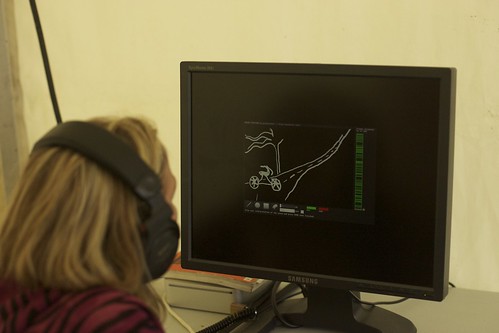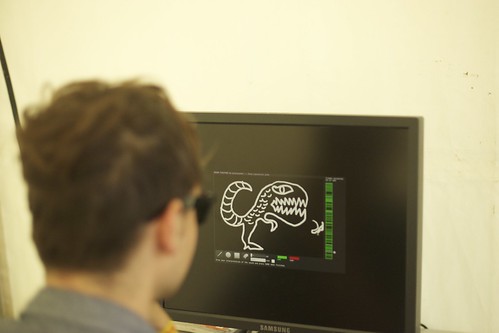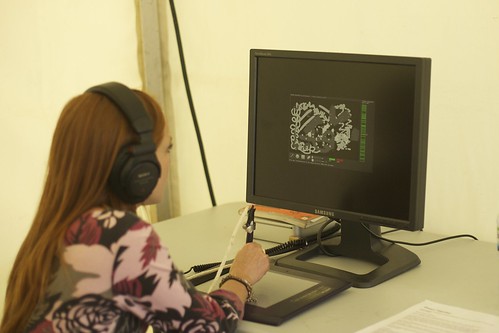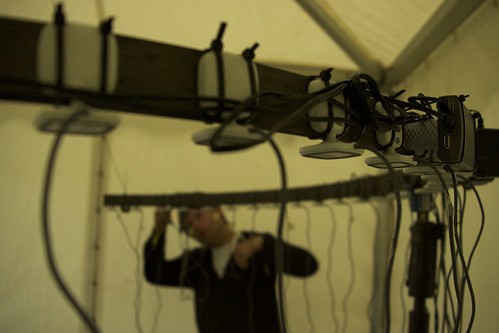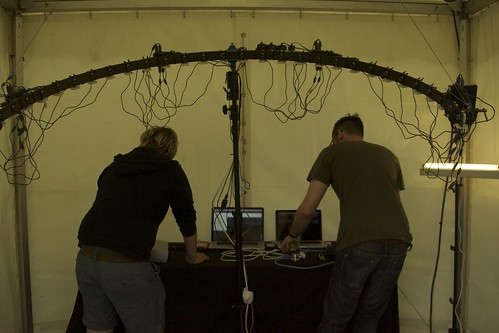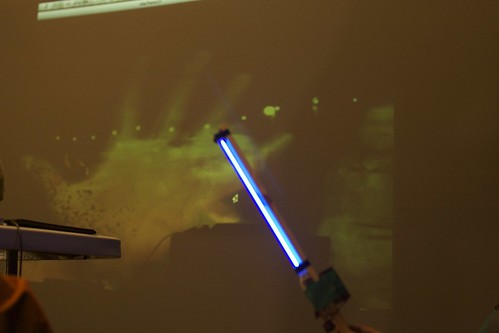The result of Drawn Together at The Big Chill festival, 4-8 August 2010:
More images here and here
Drawn together is an interactive installation project, exploring creative crowd sourcing in hand drawn music videos. It allows groups of individuals to create a music video by asking each of them to visually interpret small sections of music, and combining their work. This particular video came from the collaborative results of about 80 people drawing 211 individual drawings (frames of animation) that each interpreted a frame of audio (at 12 frames per second, that comes to 66 milliseconds).
Download the application (OSX, Windows, Linux) and source code
That’s roughly half the frames we needed to make s smooth video, so the result is pretty jerky, but I thought it was interesting to show it as a work in progress. I could have filled in the rest of the frames myself, or with my friends, but I chose not to because that would destroy the spirit of the whole project. Instead, I will show this again in Brixton in early September where we will finish the video completely with another crowd.
My first impression of all the participants was how seriously they took this project! Some of my skeptical colleagues predicted that, at a festival, many people would be all loosened up and draw anything from Jackson Pollack-infused doodles to a variety of softcore porn and low-quality graffiti. Well, the results are in and only one phallus appeared, and that was from one of our neighbors in the next tent with my permission (*someone* had to draw the first one).
Our tent neightbor, Sabrepulse, from the 8-bit radio show One Life Left, interprets, uh, dragons
The rest of the people thoughtfully bit their lip and produced a variety of sometimes abstract, sometimes representational, sometimes intricate drawings that represented the short, abstract sound looping through their headphones. A few of them put on the headphones and looked at me with questioning eyes – “I think it’s broken? There’s only this crunching sound.” Then, after listening thoughtfully, they went to work on it and produced a surprising number of pictures, like the bicycle by a country road (above).
What did we learn from this?
First, that next time I show this, I will have people sit in an “isolation booth” (which was the original idea, changed for budgetary and time-related reasons) so they are more free to doodle whatever comes into their minds. Drawing is not a social act, it is something very personal, and the headphones and looping sound make it even more so. It also takes time, and I didn’t want people to feel rushed.
Which brings me to lesson #2 – this takes a lot more time per person than I estimated. I figured, from my personal tests, that people would get into the flow of it and knock out a few frames each in a few minutes. I didn’t count on 1) having to explain it individually to 80 people and convince them it was well worth their time instead of watching Thom Yorke or hitting the Money Shoulder treehouse bar, and 2) that people would take so much time drawing extremely detailed, intricate drawing such as man-eating dinosaurs and what appeared to be a realistic rendering of the burning bush that spoke to Moses back in biblical days.
Regarding #1, I misjudged festival crowds – my experience with installations is that people go in a steady stream, but our tents (and the stuttering schedules for bands and events) produced clumps of people at odd intervals. Plus, I had to use my second computer for BulletTime (see below) so the economy of scale possible with this project was reduced to a single choke-point. No problem, that’s what the first test run is for!
With #2, I was really inspired by what I observed. This proved that simple black and white line drawings, with minimal brushes, could not only be expressive for a wide range of people (kids to parents to general revelers), but also be so immersive as to drown out a blaring, midday festival, and hold their attention for up to 15 minutes in some cases. After seeing the project with real participants, I can think of all sorts of ways to improve it, including activating the “onion-skin” mode where people can actually see the frame drawn before theirs, and the animation isn’t random but sequential starting from the beginning of the song. I would have loved to have tried this, except for lack of time and equipment. Will definitely revisit this at a future date.
Bullet Time
My two (now former) students from Digital Screen Arts at UCA Farnham, Benjamin Burdock and Christopher Belcher, came to me a little over a year ago with a crazy idea about creating a portable rig for shooting Matrix-like Bullet-time movies on the cheap. After a solid year of hard blood, sweat, steel fabrication, and coding, they finished it in time for Glastonbury. The Big Chill was the first time I got to see it in action, after some email-enabled coding and debugging sessions with Ben. The very talented Dave Morgan (another UCA grad) replaced Ben for this trip.
The result was well worth it. Bullet Time drew a good crowd every day, especially at night when we invited people to do acrobatics inside the all-seeing arc of Xbox cameras, frozen into a movie of all the cameras capturing in sequence, spinning around them like budding Neos dodging digital bullets, and rear-projected the result instantly on the side of the tent for passers-by to see.
I also learned a lot in the process, especially about how difficult and unpredictable it is to run 30 USB web cams off of 2 computers, be they shiny new MacBook pros, PCs, or Mac towers. (Test results say you can only run 6 cameras per USB hub per USB bus, for a max of 12 per laptop, in case you are crying out for an answer).
Other Highlights
MadLab (Manchester Digital Lab) and their robot building/racing exhibition; Olly Venning and his stop-frame animation workshop (and my tent-mate); and finally Tristan Brady-Jacobs and his gang doing long-exposure photography, and helped perform using a long-exposure inspired Processing sketch during Nick Rothwell’s set:
Thanks to Julia Dempsey for organizing The Swap Meet (the overall area of the festival which we were a part of) and Lewis Sykes for organizing the Cybersonica camp.
